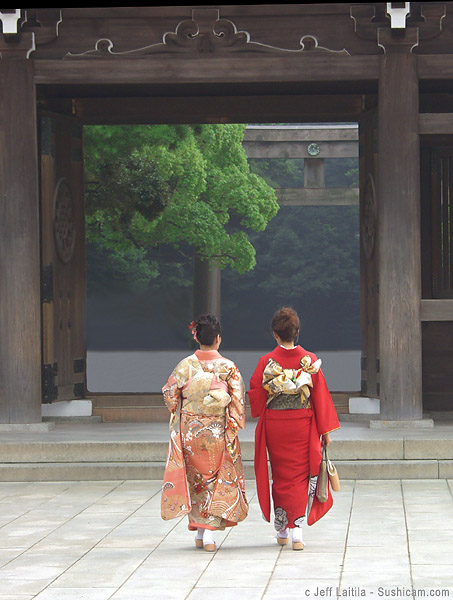Spoken Japanese
Japan is linguistically nearly a homogenous nation, with more than 99 per cent of the population using the same language. However, Japanese, like many other languages, also has many dialects, called hogen. These dialects can be divided as follows:
The Eastern dialects: The dialects of Hokkaido, Tohoku, Kanto and the eastern part of Chubu.
The Western dialects: The dialestcs of the western part of Chubu (including Nagoya City), Kansai (including Osaka, Kyoto and Kobe Cities), Chugoku, Shikoku, Kyushu and Okinawa.
The Japanese common language used to be based mainly on the dialects of the Kansai region, but since the 17th century it has become closer to the dialects of Tokyo in the Kanto region, as Japan's political and economic centre has moved from Kyoto and Osaka to Edo, present-day Tokyo. In general people from all over Japan can understand each other even if they speak different dialects
Less conspicuous, but worth addressing, is the Ainu language. This is not a Japanese dialect, but an independent language. It is the language of the indigenous peoples that live on Hokkaido, the northern island of Japan. They are ethnically and culturally different from the main Japanese population.
Honorific language: Keigo
There are several levels of politeness in the Japanese language: a colloquial, a more polite, and a very polite, honorific level (keigo). Keigo demonstrates the degree of respect that the speaker pays to the listener. Its main functions are: to do honour to the listener, to be formal, to express a humble attitude, and to maintain class and cultivation.
Basically, very humble expressions are used when referring to yourself and very honorific ones when referring to the person you are addressing. This involves different levels of speech and a wide range of words and expressions in order to produce just the desired degree of politeness. A simple sentence could be expressed in more than 20 different ways, depending on the status of the speaker relative to the person being addressed.
Keigo is classified into three types: sonkeigo, kenjougo and teineigo
Sonkeigo is the expression to use when the listener is in a higher position than the speaker.
Kenjougo is the expression to use when the speaker is in a lower position than the listener.
Teineigo is used by the speaker only to express politeness to the listener.
It is important to be conscious of speaker's position in Japanese society. For example, one is supposed to speak in an honorific language to people such as customers, teachers and elders.
Japanese writing system and usage
Kanji
Written Japanese uses about 50,000 Chinese characters, or kanji. In 1981, in an effort to make it easier to read and write Japanese, the Japanese government introduced the joyo kanji hyo (List of Chinese Characters for General Use), which includes 1,945 regular characters, plus 166 special characters used only for people's names. All government documents, newspapers, textbooks and other publications for non-specialists use only these kanji.
Hiragana
The hiragana syllabary consists of 48 syllables and is mainly used to write word endings, known as okurigana in Japanese. Hiragana are also widely used in materials for children, textbooks, animation and comic books, to write Japanese words which are not normally written with kanji, such as adverbs and some nouns and adjectives, or for words whose kanji are obscure or obsolete. Hiragana are sometimes used to write words which would normally written with katakana, in order to make them appear more "feminine", particularly in comic books and cartoons for young girls. In children's video games texts are often written entirely in hiragana or katakana.
Katakana
The katakana syllabary consists of 48 syllables and was originally considered "men's writing". Katakana is used mainly to write non-Chinese loan words, onomatopoeic words, foreign names, in telegrams and for emphasis (the equivalent of bold, italic or upper case text in English).
Romaji (Roman letters)
Romaji is the standard way of transliterating Japanese into the Latin alphabet. In everyday written Japanese, romaji can be used to write numbers and abbreviations. It is also used in dictionaries, text books and phrase books for foreign learners of Japanese.
Modern Japanese
Modern Japanese is written with a mixture of hiragana and katakana known as the kana, plus kanji. The kanji designate the chief meaningful words of the language-nouns, verbs, and adjectives. The kana designate suffixes, particles, conjunctions, and other grammatical forms. Modern Japanese texts may also include romaji, (Roman letters), the standard way of writing Japanese with the Latin alphabet, non-Japanese words written in their own script and various symbols known as kigo.
A sample text in Japanese
kanji are in red, hiragana in black and katakana in blue
Japanese and the internet
When typing Japanese on computers, most people, both Japanese and non-Japanese, use romaji, which is converted to kanji, hiragana or katakana by the input software. It is also possible to type in hiragana or katakana if using a Japanese keyboard, but few people are familiar with this method. The utility programme that is used to convert the phonetic Hiragana characters to the mixed Kanji/Hiragana/Katakana text is called the Japanese Front End Processor (FEP). It is either built in the OS or bought separately by the user.
